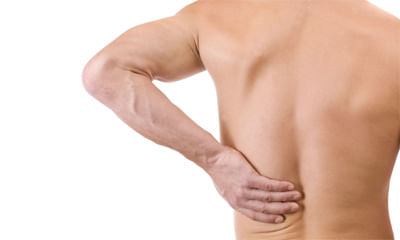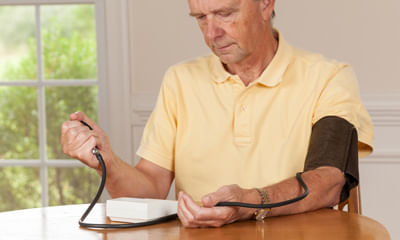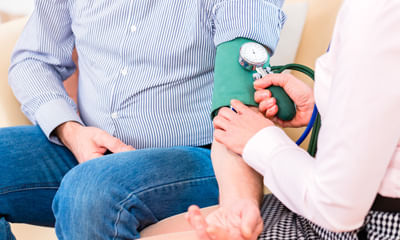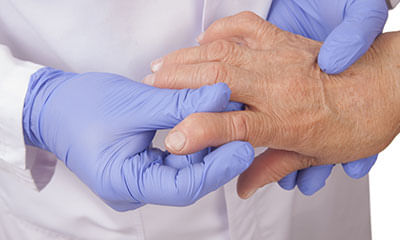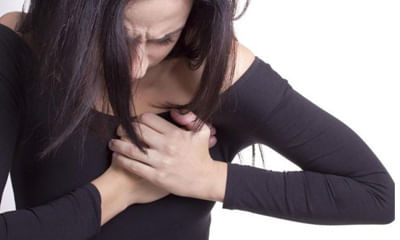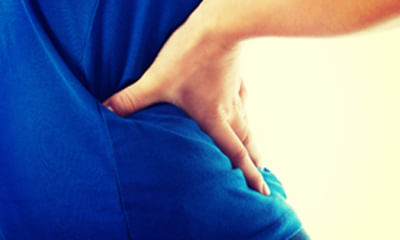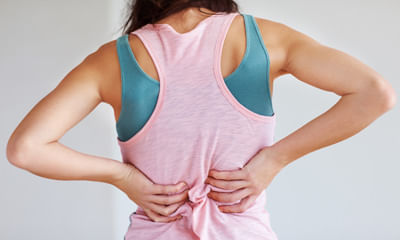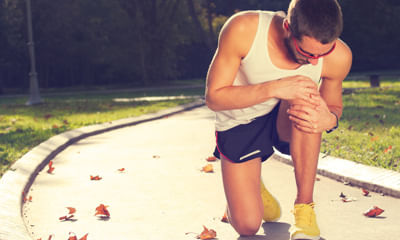Right Hand Pain Related To Heart
I am a software engineer since past 8 years age 29 I sit for 8 hours a day and exercises moderately now and then the onl ...
Ask Free Question
Back pain for young people / anaemia / general weakness palpitation of the heart please consult a physician and he will help you further to consult a cardiologist. I feel you have arrhythmia which might be the heart palpitation which is not good. Consume lot of water and take good rest in the initial days / weeks until you consult the doctor. Please take care and let us know whether you have progressed. Posture supportspoor sitting posture is a common cause of sciatica. To assist the support of your lower back many simple and effective products have been developed over time. These include: lumbar d-roll bassett frame kinesiology lumbar tape please ask your physiotherapist for their advice in what will help you most. This simple stretch helps relieve sciatica pain by loosening your gluteal and piriformis muscles, which can become inflamed and press against the sciatic nerve. 1.Lie on your back with your legs extended and your feet flexed upward. 2.Bend your right leg and clasp your hands around the knee. 3.Gently pull your right leg ac 4.Ross your body toward your left shoulder. Hold it there for 30 seconds. Remember to pull your knee only as far as it will comfortably go. You should feel a relieving stretch in your muscle, not pain. 5.Push your knee so your leg returns to its starting position. 6.Repeat for a total of 3 reps, and then switch legs. 5.sitting spinal stretch sciatica pain is triggered when vertebrae in the spine compress. This stretch helps create space in the spine to relieve pressure on the sciatic nerve. 1.Sit on the ground with your legs extended straight out with your feet flexed upward. 2.Bend your right knee and place your foot flat on the floor on the outside of your opposite knee. 3.Place your left elbow on the outside of your right knee to help you gently turn your body toward the right. 4.Hold for 30 seconds and repeat three times, then switch sides. 6. Standing hamstring stretch this stretch can help ease pain and tightness in the hamstring caused by sciatica. 1.Place your right foot on an elevated surface at or below your hip level. This could be a chair, ottoman, or step on a staircase. Flex your foot so your toes and leg are straight. If your knee tends to hyperextend, keep a slight bend in it. 2.Bend your body forward slightly toward your foot. The further you go, the deeper the stretch. Do not push so far that you feel pain. 3.Release the hip of your raised leg downward as opposed to lifting it up. If you need help easing your hip down, loop a yoga strap or long exercise band over your right thigh and under your left foot. 4.Hold for at least 30 seconds, and then repeat on the other sideif you have low back pain and sciatica you can undergo intermittent pelvic traction where in your half of your body weight will be added in the electronic traction so that that would help you to reduce the pain, along with interferential therapy stimulations which would help you to get relieved from the radiating pain. Apply ice for the pain to get subsided immediately. If you cannot go immediately for the physiotherapy treatment. Ice can be kept in the low back where you have back pain. It is suggestible to wear lumbo sacral belt which would help you to build the abdominal muscle tone which itself would make you feel better. You can also wear mcr chappals which would help you to have less weight falling in the painful back. U have to take vitamin d rich foods. Likemilk,cheese, yogurt,brocoli, spinach.u need calcium consumption for increase the bone density. Lackof bone and bones crush inside the body this might be due to low calcium or vitamin d which has more impact on the bone density and also it makes one to feel that there is lack of bone strength or in a way the bones are brittle and almost breaking and they feel it is crushed in a way there are many bones breaking at the same time. You have to take vitamin d rich foods. Likemilk,cheese, yogurt, brocoli, spinach.u need calcium consumption for increase the bone density. vitamin d intake via supplements or exposure to low levels of sunlight. Vitamin d is used to absorb calcium in the bone and regulate calcium in the blood. Back pain for young people / anaemia / general weakness palpitation of the heart please consult a physician and he will help you further to consult a cardiologist. I feel you have arrhythmia which might be the heart palpitation which is not good. Consume lot of water and take good rest in the initial days / weeks until you consult the doctor. Please take care and let us know whether you have progressed. Posture supportspoor sitting posture is a common cause of sciatica. To assist the support of your lower back many simple and effective products have been developed over time. These include: lumbar d-roll bassett frame kinesiology lumbar tape please ask your physiotherapist for their advice in what will help you most. This simple stretch helps relieve sciatica pain by loosening your gluteal and piriformis muscles, which can become inflamed and press against the sciatic nerve. 1.Lie on your back with your legs extended and your feet flexed upward. 2.Bend your right leg and clasp your hands around the knee. 3.Gently pull your right leg ac 4.Ross your body toward your left shoulder. Hold it there for 30 seconds. Remember to pull your knee only as far as it will comfortably go. You should feel a relieving stretch in your muscle, not pain. 5.Push your knee so your leg returns to its starting position. 6.Repeat for a total of 3 reps, and then switch legs. 5.sitting spinal stretch sciatica pain is triggered when vertebrae in the spine compress. This stretch helps create space in the spine to relieve pressure on the sciatic nerve. 1.Sit on the ground with your legs extended straight out with your feet flexed upward. 2.Bend your right knee and place your foot flat on the floor on the outside of your opposite knee. 3.Place your left elbow on the outside of your right knee to help you gently turn your body toward the right. 4.Hold for 30 seconds and repeat three times, then switch sides. 6. Standing hamstring stretch this stretch can help ease pain and tightness in the hamstring caused by sciatica. 1.Place your right foot on an elevated surface at or below your hip level. This could be a chair, ottoman, or step on a staircase. Flex your foot so your toes and leg are straight. If your knee tends to hyperextend, keep a slight bend in it. 2.Bend your body forward slightly toward your foot. The further you go, the deeper the stretch. Do not push so far that you feel pain. 3.Release the hip of your raised leg downward as opposed to lifting it up. If you need help easing your hip down, loop a yoga strap or long exercise band over your right thigh and under your left foot. 4.Hold for at least 30 seconds, and then repeat on the other sideif you have low back pain and sciatica you can undergo intermittent pelvic traction where in your half of your body weight will be added in the electronic traction so that that would help you to reduce the pain, along with interferential therapy stimulations which would help you to get relieved from the radiating pain. Apply ice for the pain to get subsided immediately. If you cannot go immediately for the physiotherapy treatment. Ice can be kept in the low back where you have back pain. It is suggestible to wear lumbo sacral belt which would help you to build the abdominal muscle tone which itself would make you feel better. You can also wear mcr chappals which would help you to have less weight falling in the painful back. U have to take vitamin d rich foods. Likemilk,cheese, yogurt,brocoli, spinach.u need calcium consumption for increase the bone density. Lackof bone and bones crush inside the body this might be due to low calcium or vitamin d which has more impact on the bone density and also it makes one to feel that there is lack of bone strength or in a way the bones are brittle and almost breaking and they feel it is crushed in a way there are many bones breaking at the same time. You have to take vitamin d rich foods. Likemilk,cheese, yogurt, brocoli, spinach.u need calcium consumption for increase the bone density. vitamin d intake via supplements or exposure to low levels of sunlight. Vitamin d is used to absorb calcium in the bone and regulate calcium in the blood.
Hi, I am taking high bp medicines from last dec when my bp was 150/110. I reduced my weight by 20 kg and eating normal f ...
Ask Free Question
Firstly, congratulations on the significant weight loss and the improvement in your blood pressure control. It's excellent that your blood pressure is within a healthier range. The pain you describe in the left hand near the elbow and in the shoulder, especially during brisk walking, could be due to various reasons. However, it's essential to take any chest pain or discomfort seriously and consult with your healthcare provider promptly. Given that you've experienced this pain during physical activity and you have a history of high blood pressure, it's crucial to rule out any cardiovascular concerns. Your normal echocardiogram is a positive indicator, but the pain you describe should be evaluated further. Here are a few considerations: 1. Musculoskeletal causes: pain in the left arm and shoulder could be musculoskeletal in nature, related to strain or overuse during exercise. 2. Cardiovascular causes: while your echo is normal, it's still important to consider other cardiovascular factors. Pain in the left arm can sometimes be associated with reduced blood flow. 3. Nerve impingement: nerve impingement or compression can also cause pain in the arm and shoulder. Since your symptoms have a potential cardiovascular connection, it's advisable to consult with your healthcare provider. They may recommend further cardiovascular evaluations, such as a stress test or additional imaging, to assess the heart's response to exercise. Don't ignore any unusual symptoms, especially during physical activity. It's better to be cautious and have a healthcare professional evaluate your situation. Consider scheduling a private text consult within the app to discuss your symptoms in more detail and receive personalized advice based on your health history.
Hi, I am male/31 years, suffering from less libido, pe, ed. It’s been years and years having these issue and ever year I ...
Ask Free Question
Hello- while lack of libido is sometimes related to hormonal imbalances, it's important to understand the other factors which can lower libido and contribute to erectile dysfunction and premature ejaculation. Two of the most common sexual dysfunctions that affect a large percentage of men are premature ejaculation (pe) and erectile dysfunction (ed). When it gets added by lack of libido the situation get more complicated. The incidence of these conditions have been found to be equitably spread among all socio-economic groups and can affect men of all ages. Most men who have been diagnosed with ed as a primary problem, the secondary concern in most instances is pe, the two are often thought to be mutually inclusive and are always associated with reduced sexual urge. Also because reduced or hampered blood flow, critical to achieve a penetrable erection, to the genital areas is one of the main reason for premature ejaculation and erectile dysfunction, the logic of 'one reason one problem' gets applied. In the last few decades, significant advancements in treatment procedures and options have improved the outlook for these three conditions and the comprehensive treatment is possible with the help of medications.
I am dealing with hypertension and taking amcard-at tablet daily from past 6 years ⦠sometimes I feel chest tightness ...
Ask Free Question
Good afternoon Mr. lybrate-user. I am so sorry for your symptoms. Amcard / amlip are common medications for hypertension but the symptoms specially the chest tightness is concerning. It is usually not a side effect of the medications. There could be a several reasons for chest tightness, and a doctors visit could help. Possible reasons could be uncontrolled hypertension, underlying heart disease and sometimes anxiety could cause similar symptoms. I treat hypertension and related cardiac issues. Feel free to consult me online if you need my expert comments. I will be more than happy to help and manage your issues. Thanks and get well soon.
My mother have rheumatoid arthritis since 5 year. Now she get unbearable join pain. In last 6 month she has medical hist ...
Ask Free Question
The "normal" range (or negative test result) for rheumatoid factor is less than 14 iu/ml. Any result with values 14 iu/ml or above is considered abnormally high, elevated, or positive. Treatmentthere is no cure for rheumatoid arthritis. But clinical studies indicate that remission of symptoms is more likely when treatment begins early with medications known as disease-modifying antirheumatic drugs (dmards). Medicationsthe types of medications recommended by your doctor will depend on the severity of your symptoms and how long you've had rheumatoid arthritis. •nsaids. Nonsteroidal anti-inflammatory drugs (nsaids) can relieve pain and reduce inflammation. Over-the-counter nsaids include ibuprofen (advil, motrin ib) and naproxen sodium (aleve). Stronger nsaids are available by prescription. Side effects may include stomach irritation, heart problems and kidney damage. •steroids. Corticosteroid medications, such as prednisone, reduce inflammation and pain and slow joint damage. Side effects may include thinning of bones, weight gain and diabetes. Doctors often prescribe a corticosteroid to relieve acute symptoms, with the goal of gradually tapering off the medication. •disease-modifying antirheumatic drugs (dmards). These drugs can slow the progression of rheumatoid arthritis and save the joints and other tissues from permanent damage. Common dmards include methotrexate (trexall, otrexup, others), leflunomide (arava), hydroxychloroquine (plaquenil) and sulfasalazine (azulfidine). Side effects vary but may include liver damage, bone marrow suppression and severe lung infections. •biologic agents. Also known as biologic response modifiers, this newer class of dmards includes abatacept (orencia), adalimumab (humira), anakinra (kineret), baricitinib (olumiant), certolizumab (cimzia), etanercept (enbrel), golimumab (simponi), infliximab (remicade), rituximab (rituxan), sarilumab (kevzara), tocilizumab (actemra) and tofacitinib (xeljanz). These drugs can target parts of the immune system that trigger inflammation that causes joint and tissue damage. These types of drugs also increase the risk of infections. In people with rheumatoid arthritis, higher doses of tofacitinib can increase the risk of blood clots in the lungs. Biologic dmards are usually most effective when paired with a nonbiologic dmard, such as methotrexate. Therapy your doctor may send you to a physical or occupational therapist who can teach you exercises to help keep your joints flexible. The therapist may also suggest new ways to do daily tasks, which will be easier on your joints. For example, you may want to pick up an object using your forearms. Assistive devices can make it easier to avoid stressing your painful joints. For instance, a kitchen knife equipped with a hand grip helps protect your finger and wrist joints. Certain tools, such as buttonhooks, can make it easier to get dressed. Catalogs and medical supply stores are good places to look for ideas. Surgeryif medications fail to prevent or slow joint damage, you and your doctor may consider surgery to repair damaged joints. Surgery may help restore your ability to use your joint. It can also reduce pain and improve function. Rheumatoid arthritis surgery may involve one or more of the following procedures: •synovectomy. Surgery to remove the inflamed lining of the joint (synovium) can be performed on knees, elbows, wrists, fingers and hips. •tendon repair. Inflammation and joint damage may cause tendons around your joint to loosen or rupture. Your surgeon may be able to repair the tendons around your joint. •joint fusion. Surgically fusing a joint may be recommended to stabilize or realign a joint and for pain relief when a joint replacement isn't an option. •total joint replacement. During joint replacement surgery, your surgeon removes the damaged parts of your joint and inserts a prosthesis made of metal and plastic. Surgery carries a risk of bleeding, infection and pain. Discuss the benefits and risks with your doctor. Rheumatoid arthritis multiple joint pains / early morning painit is called as rheumatic arthritis. Treatment goals •to protect the joint from further damages. •provide pin relief. •prevent deformity and disabilities. •increase functional capacity. •improve flexibility and strength. •encourage regular exercise. •improve general fitness. Physiotherapy modalities - hot/cold applications- electrical stimulation- hydrotherapy and spa therapy rehabilitation treatment technique - rest and splinting - compression gloves - assistive devices and adaptive equipment - massage therapy - therapeutic exercise - patient education assistive devices and adaptive equipment occupational therapy improves functional ability in patients with ra. Occupational therapy interventions such as assistive devices and adaptive equipments have beneficial effects on joint protection and energy conservation in arthritic patients.Assistive devices are used in order to reduce functional deficits, to diminish pain, and to keep patients' independence and self-efficiency. Loading over the hip joint may be reduced by 50% by holding a cane. In fact, most of these instruments are originally designed for patients with neurologic deficits; therefore, certain adaptations may be needed for them to be used in patients with arthritis. Elevated toilet seats, widened gripping handles, arrangements related with bathrooms, etc. Might all facilitate the daily life. The procedures needed to increase compliance of the patient with the environment and to increase functional independence are +mainly determined by the occupational therapist. Massage therapy that improves flexibility, enhances a feeling of connection with other treatment modalities, improves general well being, and can help to diminish swelling of inflamed joints. Massage is found to be effective on depression, anxiety, mood, and pain. Therapeutic exercise every joint should be moved in the rom at least once per day in order to prevent contracture. In the case of acutely inflamed joints, isometric exercises provide adequate muscle tone without exacerbation of clinical disease activity. Moderate contractures should be held for 6 seconds and repeated 5–10 times each day. Dynamic exercise therapy in improving joint mobility, muscle strength, aerobic capacity and daily functioning in patients with rheumatoid arthritis (ra). Finally, in chronic stage with inactive arthritis, conditioning exercises such as swimming, walking, and cycling with adequate resting periods are recommended. They increase muscle endurance and aerobic capacity and improve functions of the patient in general, and they also make the patient feel better. It might be due to lack of blood circulation which is the reason for you to have scrotum pain / back pain. You have to do basic aerobic exercises for you to become fit and also to maintain the blood circulation and tone. Patient education in patients with ra, sociopsychological factors affecting the disease process such as poor social relations, disturbance of communication with the environment, and unhappiness and depression at work are commonly encountered. The treatment of rheumatic diseases should provide education and information to their patients about their condition and the various physical therapy and rehabilitative options that are available to improve their quality of life. Passive treatments for rheumatoid arthritis •cold therapy reduces circulation, which ultimately decreases swelling. For example, a cold compress may be placed on the painful area. •cold therapy in acute phase •dosage 10-20mints/1-2 times a day. •heat therapy eases muscle tension and gets blood to flow more quickly to the painful area. For example, a moist, warm cloth may be used to promote circulation. •heat therapy in chronic phase •dosage 20-30mints/1-2 times a day. •hydrotherapy involves reducing your ra-related pain and other symptoms with water. With hydrotherapy, you will be submerged in warm water to relieve your symptoms. •massage can help reduce muscle tension and promote good circulation. It's also a fantastic way to help you manage stress (especially important for people with rheumatoid arthritis). •transcutaneous electrical nerve stimulation (tens) works by blocking pain signals from getting to your spinal cord. It also helps decrease muscle spasms. •tens short term pain relief (6 to 18 hrs) •ultrasound creates warmth using sound waves, whichenchanes circulation and decreases joint pain, inflammation, and stiffness. Exercise for acute phase: •preformed exercise at least once a day. •general assisted movement through normal range (joint mobilisation). •isometric-“static movements” helps to maintain muscle tone without increasing inflammation. Exercise for the chronic phase: •can progress the above exercise to include use of light resistance. •postural/core stability exercises. •swimming/walking/cycling to maintain cardiovascular fitness. •gentle stretch for areas that become tight, such as knees &calves. Regular exercises: •maintaing muscle strength is important for joint stability & preventing injury. •muscles can become weak following reduced activity. •pain signals from yours nerves and swelling can both inhibits muscles. •muscle length can be affected by prolonged positions immobilization and tightness can limit daily activities. Alternative therapies: •thi chi. •musical therapy. •yoga therapy. •relaxation techniques. •pilates. Active treatments for rheumatoid arthritis •flexibility and strengthening exercises improve your range of motion and help you build muscle strength. Yoga and pilates are flexibility and strengthening exercises. •low-impact aerobic exercise is gentle but effective at helping you manage rheumatoid arthritis symptoms. Light walking is an example of this type of exercise. Your physical therapist will let you know how often to do these exercises. For example, you may need to do a few specific exercises 3 times a day, or your physical therapist may recommend a routine that incorporates 30 minutes of low-impact aerobic exercise a day and 30 minutes of strengthening exercises every other day. If your pain is more in the proximal joints, ie.in the upper limbs if the pain is present in the fingers/wrist and in the lower limbs it the pain is present in the toes/ ankle, then we shall definitely say it is rheumatic arthritis. Wear elbow brace and wrist brace which will make her to feel warm and that will make the joints become firm. Hot water fermentation will helpknee cap will also help to prevent the damaged cartilagesif your pain is more in the distal joints, ie. In the upper limbs if the pain is present in the fingers/wrist and in the lower limbs it the pain is present in the toes/ ankle, then we shall definitely say it is rheumatic arthritis. If your proximal joints (ie. Shoulder, hip & knee has pain) then you can pour hot (warm) water in that area to reduce the inflammation. If you have pain in the distal joints ie. Wrist, fingers, ankle, toes then you can wear either elbow brace or wrist brace which will help you to feel warm and very protective. And also immerse the distal joints in the hot water tub which will help you to reduce the pain. Knee pain during driving or watching movie. It might due to lack of movements in the knee while the joints are immobilized during driving and while watching movies. It is important that you need to have movements in and around the knee so that the blood flow will not be disturbed.
Hi sir, pradeep here form bangalore, I am currently 33 years old unmarried with no peace in life for the past 8 months d ...
Ask Free Question
Answer—i have gone through your details of health problems -- having stress regarding physical symptoms ; fits; palpitations ; gastro-intestinal and neuralgic type of symptoms –with anxiety –are your health problems--in this background you requires treatment including sessions by psychiatrist—psychologist—psycho-social worker team ; cardiologist ; gastroenterologist and neurologist along with efforts from your side for lifestyle changes as described below- from your explanation --i feel that your problems are related to stopping medicines at your own level with out advice from the docyor ---especially for fits ;uncontrolled and irregular daily schedule of activities ---with anxiety and desire for achieving targets and overstrain and overwork ----all these leading to palpitation ;depression ; stomach upset; neuralgia etc. So your treatment is to start with lifestyle changes ----- you make a healthy schedule of daily activities with correct timings for sleeping; working ; eating ; entertainments ; exercise ;yoga ; meditation ; prayers ; social and religious activities and then -- strictly follow the schedule --- booster your mental health by increasing positive mental energy by 1-convincing yourself that you have no major cardiac or deadly disease and there are people around you who are suffering more than you and need your help – like poor cancer; kidney patients. Still some of them are always smiling ; helping; supporting ; encouraging and appreciating others upto their last breathe —read stories of such people –which are coming in media and you try to do the same--- to your family members; neighbors ; colleagues –and poor patients in cancer wards etc -- ----- 2---reduce your negative mental energy like anger ; anxiety ; fear ; depression ; jealousy ; selfishness etc. By being philosophical about our momentary journey of-life--- of maximum 40000 days --in this beautiful world --where we forget to enjoy the good things-- due to our passion for sincerity ;over anxiety about own health ; status etc and greed for possessions ; selfish interests etc. -- just smile and try to make happiness to your fellow passengers like your parents; wife; children ; neighbors; colleagues and try to forget your health problems --at least for few hours daily & accrue positive energy in your soul ---which is one of the best medicines for your problems and the only item which we can take from this world ---when we are going finally.mobile so you make a diary of your good and bad deeds daily and make sure that the good deeds are more every day -----you sleep --only after making this diary notes --you tabulate your monthly balance and see that it is positive --- --- now let us look at your daily food menu --- take about 300 gm of fresh vegetables and glv and fruits before your lunch and dinner daily as fresh salads or fresh juice. Drink 12-14 glasses of water /fluids daily / restrict oily; fried ; fatty ; junk ; fast food items and avoid colas; alcohol ; tobacco and drugs and take maximum ethnic vegetarian food // take food in small quantity at frequent intervals // don't take food during your screen time // take your dinner before 8 pm //restrict your food in dinner parties and lunch parties / // restrict your screen time to 3 hours daily // if you are a computer professional ---take 5 minutes of rest every 1 hour at computer --go round in office --chit chat or look at distance -wash face and come back to work ---- sleep for 8 hours daily --that also at fixed timings --if your work permits // have any type of entertainment for 1 hour daily // keep regular fixed time for passing stool -twice daily ; passing urine every 3-4 hours; brushing teeth twice daily and taking bath twice daily. Do exercise for 30 minutes daily --like walking; cycling; swimming etc. // do yoga; pranayama ; meditation for 20 minutes daily //have prayers for 20 minutes daily --if you are a believer. After starting a daily schedule of your activities with the above advice and continuing for 2 months --you assess-- by yourself-- about the health problems still remaining ---like palpitation ; fits ;anxiety etc and go to a good hospital like cmc; vellore ----meet a group of good psychiatrist—psychologist – psycho social worker team; cardiologist ; gastroenterologist ; neurologist as per your main problems--- take treatment as they instructs and continue the new lifestyle which you have strated 2 months ago ---as detailed above -- --thank you for your question ----which explains the problems of many people at present----.wish you all the best.
I have severe chest pain sometimes. My hands and feet get cold also. There is some kind of sensation in my stomach as we ...
Ask Free Question
I am sorry to hear about your concern but will be happy to assist you. Muscle or bone problems can cause sudden, sharp chest pain. Your ribs and the muscles between them can get injured or bruised by working out, carrying something heavy, or in a fall. You can also sprain a muscle in your chest wall. Chest muscle or bone strain can lead to a sudden, sharp pain in your chest. Let's connect over a call so that we can discuss your concern in details and make a suitable treatment plan for you.
Hello doctor sometimes I have pain in my rest which last for seconds. I also have neck, shoulder and left hand pain on t ...
Ask Free Question
Regards Lybrate user. Pain in the shoulder & left arm may occur due to referred pains from neck, heart, at times stomach. If there is pain or limitation of movements in the neck and if the neck pain worsens proportionately with the shoulder/arm pain, they both could be related. Body structures around the shoulder itself may at times refer pain down the arm up to the wrist/hand. If shoulder movements are painful and/or limited, along with worsening of pain down the arm/forearm, then it could be related. Pain from the heart may also radiate to the same area. However, pain from heart will occur with activity when heart has to work more (for example climbing stairs, or jogging or lifting any weight). Rarely, heart related pains may occur even at rest or at sleep as well. It matters to find the symptoms and try to relate them logically to know which structures could be causing the disorder. It is recommended to consult an orthopaedician or orthopaedic physiotherapist for further evaluation. You may feel free to reach out to us for a virtual consult as well. You may use doctor code as drc221.
Hi, my mother (age-51) was facing pain in her left hand, back & sometimes chest also. She have some cervical pain and ha ...
Ask Free Question
For cervical pain counslt to physio. Use cervical collar. Avoid high pillow sleep. Do regular exercises. Drink much water. Thnks.
Hello Dr. Since few months I have pain in my hands fingers and in my legs and most importantly pain in chest but only at ...
Ask Free Question
What r other symptoms that you r experiencing? By doing what like walking, exertion, eating or empty stomach- it increases or decreases in intensity. For how much time the pain remains? Is there stiffness also? How is your appetite? R you constipated? Any problem in urine? I need details of case. In the meanwhile follow this 1. Don't take tea empty stomach. Eat something like a banana (if you are not diabetic) or any seasonal fruit or soaked almonds and a glass of water first thing in the morning (within 10 mins of waking up). No only biscuits or rusk will not do. 2. Don't overeat 3. Take your breakfast every day. Don't skip it. U should eat whatever your mother or grandparent eat in bfast. I mean to say whatever is your traditional food. If punjabi eat paratha, if belongs to south then take idli/ dosa etc. 4. Have light meals every 2 hours (in addition to your breakfast, lunch n dinner) e.g. Nariyal paani, chaach, a handful of dry fruits, a handful of peanuts, any fresh n seasonal fruit, a cup of curd/milk etc 5. Finish your dinner at least 2 hours before going to sleep. 6. Maintain active life style7. Avoid fast foods, spicy n fried foods, carbonated beverages 8. Take a lot of green vegetables n fruit. 9. Drink lot of water.10. Everyday preferably sleep on same time exercise in the form of yoga, cycling, swimming, gym etc. Till lockdown do suryanamaskar every day. for this homeopathy offers good results. Consult online with details.

